Stars/Sun/Heliognosy
< Stars < Sun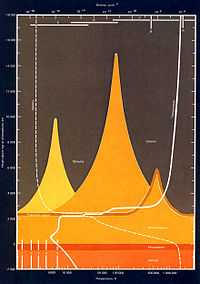
The Sun is sometimes called Sol and other times Helio. Heliognosy is the science of the Sun's composition or constitution.
The image at the right describes graphically the temperature and density of the Sun's atmosphere from the photosphere upwards. "The Sun's photosphere has a temperature between 4500 and 6000 K[1] (with an effective temperature of 5777 K) and a density of about [2 x 10-4kg/m3",[2] where other stars may have hotter or cooler photospheres.
Helionomy
Astronomy of the Sun may be called helionomy.
Colors
Def. "[t]he natural medium emanating from the sun and other very hot sources (now recognised as electromagnetic radiation with a wavelength of 400-750 nm), within which vision is possible"[3] is called light.
Def. "emitting light"[4] is called luminous.
Minerals
"In the 1920s, Payne [3] and Russell [4] reported that the Sun’s atmosphere consisted mostly of hydrogen (H) and helium (He), but Hoyle [5] notes that he and others "in the astronomical circles to which I was privy" (p. 153) continued until after the Second World War to believe that the Sun was made mostly of iron. Then Hoyle notes that "much to my surprise" (p. 154), the high-hydrogen, low-iron model was suddenly adopted without opposition."[5]
Theoretical heliognosy
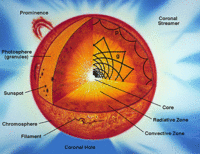
Def. "[a] luminous celestial body, made up of plasma (particularly hydrogen and helium) and having a spherical shape"[6] is called a star.
"Depending on context the sun may or may not be included."[6] In the model shown at right the Sun and regions around it are labeled.
Cores
"The core of the Sun is considered to extend from the center to about 0.2 to 0.25 solar radius.[7] It is the hottest part of the Sun and of the Solar System. It has a density of up to 150 g/cm³ (150 times the density of liquid water) and a temperature of close to 15,000,000 kelvin [15 MK] ... The core is made of hot, dense gas in the plasmic state. The core, inside 0.24 solar radius, generates 99% of the fusion power of the Sun."[8] It is in the core region that solar neutrinos may be produced.
Radiative zones
"The radiation zone or radiative zone is a layer of a star's interior where energy is primarily transported toward the exterior by means of radiative diffusion, rather than by convection.[9] Energy travels through the radiation zone in the form of electromagnetic radiation as photons. Within the Sun, the radiation zone is located in the intermediate zone between the solar core at .2 of the Sun's radius and the outer convection zone at .71 of the Sun's radius.[9]"[10]
"Matter in a radiation zone is so dense that photons can travel only a short distance before they are absorbed or scattered by another particle, gradually shifting to longer wavelength as they do so. For this reason, it takes an average of 171,000 years for gamma rays from the core of the Sun to leave the radiation zone. Over this range, the temperature of the plasma drops from 15 million K near the core down to 1.5 million K at the base of the convection zone.[11]"[10]
"Within a radiative zone, the temperature gradient—the change in temperature (T) as a function of radius (r)—is given by:
where κ(r) is the opacity, ρ(r) is the matter density, L(r) is the luminosity, and σ is the Stefan–Boltzmann constant.[9] Hence the opacity (κ) and radiation flux (L) within a given layer of a star are important factors in determining how effective radiative diffusion is at transporting energy. A high opacity or high luminosity can cause a high temperature gradient, which results from a slow flow of energy. Those layers where convection is more effective than radiative diffusion at transporting energy, thereby creating a lower temperature gradient, will become convection zones.[12]"[10]
Convection zones
"The convection zone of a star is the range of radii in which energy is transported primarily by convection. ... Stellar convection consists of mass movement of plasma within the star which usually forms a circular convection current with the heated plasma ascending and the cooled plasma descending."[13] This is the granular zone in the outer layer of a star.
"The solar dynamo is the physical process that generates the Sun's magnetic field. The Sun is permeated by an overall dipole magnetic field, as are many other celestial bodies such as the Earth. The dipole field is produced by a circular electric current flowing deep within the star, following Ampère's law. The current is produced by shear (stretching of material) between different parts of the Sun that rotate at different rates, and the fact that the Sun itself is a very good electrical conductor (and therefore governed by the laws of magnetohydrodynamics)."[14]
Electromagnetics
"The electric-sun hypothesis assigns the solar body the role of anode - that of the higher-potential electrode - in a cosmical electric discharge."[15]
The "Sun is not an electrically isolated body in space, but the most positively charged object in the solar system, the center of a radial electric field."[16]
Meteors
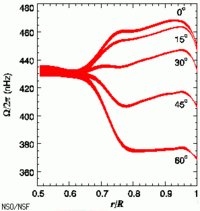
"Sun-grazing comets almost never re-emerge, but their sublimative destruction near the sun has only recently been observed directly, while chromospheric impacts have not yet been seen, nor impact theory developed."[17] "[N]uclei are ... destroyed by ablation or explosion ... in the chromosphere, producing flare-like events with cometary abundance spectra."[17]
"The death of a comet at r ~ R⨀ has been seen directly only very recently (Schrijver et al 2011) using the SDO AIA XUV instrument. This recorded sublimative destruction of Comet C/2011 N3 as it crossed the solar disk very near periheloin q = 1.139R⨀."[17]
"The phenomenon of flare induced sunquakes - waves in the photosphere - discovered by Kosovichev and Zharkova (1998) and now widely studied (e.g. Kosovichev 2006) should also result from the momentum impulse delivered by a cometary impact."[17]
"[D]ifferent parts of the Sun ... rotate at different rates"[14].
At right is a diagram of the internal rotation in the Sun, showing differential rotation in the outer convective region and almost uniform rotation in the central radiative region. The transition between these regions is called the tachocline.
"Until the advent of helioseismology, the study of wave oscillations in the Sun, very little was known about the internal rotation of the Sun. The differential profile of the surface was thought to extend into the solar interior as rotating cylinders of constant angular momentum.[18] Through helioseismology this is now known not to be the case and the rotation profile of the Sun has been found. On the surface the Sun rotates slowly at the poles and quickly at the equator. This profile extends on roughly radial lines through the solar convection zone to the interior. At the tachocline the rotation abruptly changes to solid body rotation in the solar radiation zone.[19]"[20]
Cosmic rays
"[T]he relative abundances of solar cosmic rays reflect those of the solar photosphere for multicharged nuclei with approximately the same nuclear charge-to-mass ratio."[21]
X-rays
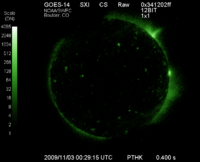
The GOES 14 spacecraft carries a solar X-ray Imager that took the image of the Sun at the right during the most recent quiet period. The Sun appears dark because of the wavelength band of observation. The photosphere of the Sun does not emit X-rays.
"X-ray photons can be effectively backscattered by photosphere atoms and electrons (Tomblin 1972; Bai & Ramaty 1978). ... [A]t energies not dominated by absorption the backscattered albedo flux must be seen virtually in every solar flare spectrum, the degree of the albedo contribution depending on the directivity of the primary X-ray flux (Kontar et al. 2006). The solar flare photons backscattered by the solar photosphere can contribute significantly (the reflected flux is 50-90 % of the primary in the 30 - 50 keV range for isotropic sources) to the total observed photon spectrum. for the simple case of a power-law-like primary solar flare spectrum (without albedo), the photons reflected by the photosphere produce a broad 'hump' component. Photospheric albedo makes the observed spectrum flatter below ~ 35 keV and slightly steeper above, in comparison with the primary spectrum."[22]
Visuals
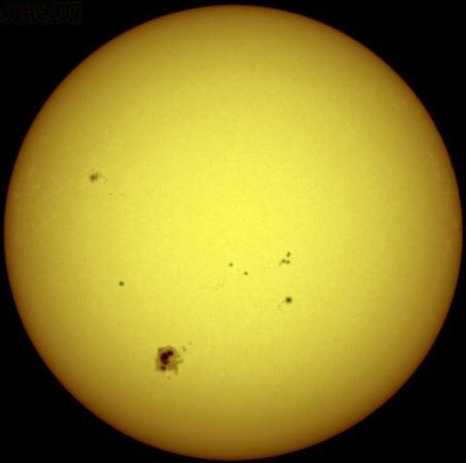
Def. "[a] visible surface layer of a star, and especially that of a sun"[23] is called a photosphere.
"When we speak of the surface of the Sun, we normally mean the photosphere."[24] "[T]he photosphere may be thought of as the imaginary surface from which the solar light that we see appears to be emitted. The diameter quoted for the Sun usually refers to the diameter of the photosphere."[24] The photosphere emits visual, or visible, radiation.
Illumination of the Sun's photosphere is in part by gamma rays. "Each gamma ray [that interacts with the photosphere] is converted into several million photons of visible light ... At the visible surface of the Sun, the temperature has dropped to 5,700 K and the density to only 0.2 g/m3 (about 1/6,000th the density of air at sea level).[25]"[26]
"The tremendous power output of the Sun is not due to its high power per volume, but instead due to its large size. ... Above the photosphere visible sunlight is free to propagate into space, and its energy escapes the Sun entirely. The change in opacity is due to the decreasing amount of H− ions, which absorb visible light easily.[27] Conversely, the visible light we see is produced as electrons react with hydrogen atoms to produce H− ions.[28][29] ... The photosphere has a particle density of ~1023 m−3 (this is about 0.37% of the particle number per volume of Earth's atmosphere at sea level; however, photosphere particles are electrons and protons, so the average particle in air is 58 times as heavy)."[26]
Photosphere volumes
R⊙eq ≈ 6.955 x 105 km. The thickness of the photosphere is about 400 km. R⊙p ≈ 6.951 x 105 km.
Photosphere hydrogens
The density of the Sun is about 2 x 10-4 kg m-3. Or,
One mole of H2 (gas) has a mass of 2.016 x 10-3 kg. The molar density of the photosphere may be
Constant volume specific heat capacity
For H2 (gas) the molar constant-volume heat capacity at 298 K is 20.18 J/(mol · K). At 2000 K it is about 25 J/(mol · K). Using a linear extrapolation,
for 5777 K, yields
Before calculating the amount of energy or power necessary to heat the coronal clouds around the Sun, let's see if the influx of electrons from outside the heliosphere may be able to heat the surface of the photosphere (p) to 5777 K from 100 K.
Photosphere heating
Voyager 1 is 17,932,000,000 km (119.9 AU) from the Sun at RA 17.163h Dec +12.44°, ecliptic latitude of 34.9°.
For this laboratory example, let the electron flux be 2 e- cm-2 s-1 diffusing into our solar system from elsewhere in the galaxy. Each of these electrons has an energy of 10 MeV.
If the electron flux measured by Voyager 1 is close to 2 e- cm-2 s-1 where each electron averages 10 MeV and these electrons are heading for the Sun, then each electron may strike the photosphere from anywhere in a sphere around the Sun.
To heat the photosphere to 5777 K takes
The power (P) that may be deposited on the photospheric surface of the Sun is
The luminosity (in Watts, W) of the Sun is 3.846 x 1026 W. In eV/s this is
If the energy of the incoming electrons is 700 MeV and the flux is 8.48 x 104 e- cm-2 s-1, then the power from the incoming electrons would be
Cyans
"An excess brightness [at or near the "edge" of the Sun] can be expected to have a pronounced color dependence, whereas a geometrical oblateness cannot depend on color."[30]
"[T]he blue contrast lies about 1 σ above the λ-1 curve. ... [I]f real, [this] may be the result of an increasing opacity in the blue and an increasing ΔT/T in the upper layers of the photosphere. An increasing opacity in the blue may be due to line haze since the blue filter has a 78 nm width."[30]
Plasma objects
The solar photosphere is a "weakly ionized [ni/(ni + na)] ~ 10-4, relatively cold and dense plasma".[31]
Metallicities
For stars, "the metallicity is often expressed as "[Fe/H]", which represents the logarithm of the ratio of a star's iron abundance compared to that of the Sun (iron is not the most abundant heavy element, but it is among the easiest to measure with spectral data in the visible spectrum). The formula for the logarithm is expressed thus:
![[\mathrm{Fe}/\mathrm{H}] = \log_{10}{\left(\frac{N_{\mathrm{Fe}}}{N_{\mathrm{H}}}\right)_{star}} - \log_{10}{\left(\frac{N_{\mathrm{Fe}}}{N_{\mathrm{H}}}\right)_{sun}}](../I/m/5e94f3081d84dda270d98cff86433233.png)
where  and
and  are the number of iron and hydrogen atoms per unit of volume respectively. The unit often used for metallicity is the "dex" which is a (now-deprecated) contraction of decimal exponent.[32] By this formulation, stars with a higher metallicity than the Sun have a positive logarithmic value, while those with a lower metallicity than the Sun have a negative value. The logarithm is based on powers of ten; stars with a value of +1 have ten times the metallicity of the Sun (101). Conversely, those with a value of -1 have one tenth (10 −1), while those with -2 have a hundredth (10−2), and so on.[33] Young Population I stars have significantly higher iron-to-hydrogen ratios than older Population II stars. Primordial Population III stars are estimated to have a metallicity of less than −6.0, that is, less than a millionth of the abundance of iron which is found in the Sun."[34]
are the number of iron and hydrogen atoms per unit of volume respectively. The unit often used for metallicity is the "dex" which is a (now-deprecated) contraction of decimal exponent.[32] By this formulation, stars with a higher metallicity than the Sun have a positive logarithmic value, while those with a lower metallicity than the Sun have a negative value. The logarithm is based on powers of ten; stars with a value of +1 have ten times the metallicity of the Sun (101). Conversely, those with a value of -1 have one tenth (10 −1), while those with -2 have a hundredth (10−2), and so on.[33] Young Population I stars have significantly higher iron-to-hydrogen ratios than older Population II stars. Primordial Population III stars are estimated to have a metallicity of less than −6.0, that is, less than a millionth of the abundance of iron which is found in the Sun."[34]
Hydrogens
Depending primarily upon gas temperature, the presence of gas may be used to determine the composition of the gas object observed, at least the outer layer. Early spectroscopy[35] of the Sun using estimates of "the line intensities of several lines by eye [to derive] the abundances of ... elements ... [concluded] that the Sun [is] largely made of hydrogen."[36]
As temperature increases in an astronomical object composed of H2 gas, the molecules begin to dissociate.
"At a temperature of 8000 K, hydrogen gas is 99.99 percent monatomic."[37]
where  is an initial concentration [H] at low temperatures as partial particle density,
is an initial concentration [H] at low temperatures as partial particle density,  is the dissociation energy 4.52 eV, k is Boltzmann's contant (8.6173324(78)×10−5 eV K-1), and T is temperature in K.
is the dissociation energy 4.52 eV, k is Boltzmann's contant (8.6173324(78)×10−5 eV K-1), and T is temperature in K.
Using
- what is the concentration of H ([H]) at T = 8000 K?
- what is [H] at T = 800 K?
- at what temperature is [H] = 1?
- what is [H] at T = 5778 K?
At 5778 K [H] = 8 %.
Atmospheres
"The parts of the Sun above the photosphere are referred to collectively as the solar atmosphere.[27]"[26]
"The structure of the solar atmosphere strongly suggests that the Sun is fueled not from within but from without, and that the energy-delivery mechanism is an electric discharge.[38][39][40]"[15]
Recent history
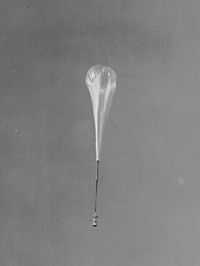
The recent history period dates from around 1,000 b2k to present.
"The Stratoscopes were two balloon-borne astronomical telescopes which flew from the 1950s to the 1970s and observed in the optical and infrared regions of the spectrum. Both were controlled remotely from the ground."[42]
"Stratoscope I possessed a 12 inch (30.48 cm) mirror and was first flown in 1957. It was conceived by Martin Schwarzschild and built by the Perkin Elmer Corporation. A small secondary mirror focussed the image from the primary into a 35 mm movie camera, which captured the images on film. Schwarzschild used the telescope to study the turbulence and granulation in the Sun's photosphere."[42]
Research
Hypothesis:
- The internal temperature of the Sun is a constant rather than steadily increasing from compression.
Control groups

The findings demonstrate a statistically systematic change from the status quo or the control group.
“In the design of experiments, treatments [or special properties or characteristics] are applied to [or observed in] experimental units in the treatment group(s).[43] In comparative experiments, members of the complementary group, the control group, receive either no treatment or a standard treatment.[44]"[45]
Proof of concept
Def. a “short and/or incomplete realization of a certain method or idea to demonstrate its feasibility"[46] is called a proof of concept.
Def. evidence that demonstrates that a concept is possible is called proof of concept.
The proof-of-concept structure consists of
- background,
- procedures,
- findings, and
- interpretation.[47]
See also
References
- ↑ The Sun - Introduction
- ↑ "SP-402 A New Sun: The Solar Results From Skylab".
- ↑ "light, In: Wiktionary". San Francisco, California: Wikimedia Foundation, Inc. June 2, 2012. Retrieved 2012-07-05.
- ↑ "luminous, In: Wiktionary". San Francisco, California: Wikimedia Foundation, Inc. July 5, 2012. Retrieved 2012-07-05.
- ↑ O. Manuel, C. Bolon, A. Katragada, and M. Insall (2001). "Attraction and Repulsion of Nucleons: Sources of Stellar Energy". Journal of Fusion Energy 19 (1): 93-8. doi:10.1023/A:1012290028638. http://link.springer.com/article/10.1023/A:1012290028638. Retrieved 2014-04-13.
- 1 2 "star, In: Wiktionary". San Francisco, California: Wikimedia Foundation, Inc. June 22, 2012. Retrieved 2012-07-05.
- ↑ García, Ra; Turck-Chièze, S; Jiménez-Reyes, Sj; Ballot, J; Pallé, Pl; Eff-Darwich, A; Mathur, S; Provost, J (June 2007). "Tracking solar gravity modes: the dynamics of the solar core". Science 316 (5831): 1591–3. doi:10.1126/science.1140598. ISSN 0036-8075. PMID 17478682.
- ↑ "Solar core, In: Wikipedia". San Francisco, California: Wikimedia Foundation, Inc. October 12, 2012. Retrieved 2012-11-23.
- 1 2 3 Ryan, Sean G.; Norton, Andrew J. (2010). Stellar Evolution and Nucleosynthesis. Cambridge University Press. p. 19. ISBN 0-521-19609-4. http://books.google.com/books?id=V8rBIudlniAC&pg=PA19.
- 1 2 3 "Radiation zone, In: Wikipedia". San Francisco, California: Wikimedia Foundation, Inc. November 9, 2012. Retrieved 2012-11-23.
- ↑ Elkins-Tanton, Linda T. (2006). The Sun, Mercury, and Venus. Infobase Publishing. p. 24. ISBN 0-8160-5193-3. http://books.google.com/books?id=Kx6q_fyqIKYC&pg=PA24.
- ↑ LeBlanc, Francis (2011). An Introduction to Stellar Astrophysics (2nd ed.). John Wiley and Sons. p. 168. ISBN 1-119-96497-0. http://books.google.com/books?id=jAe4P3GIZRoC&pg=PA168.
- ↑ "Convection zone, In: Wikipedia". San Francisco, California: Wikimedia Foundation, Inc. October 12, 2012. Retrieved 2012-11-23.
- 1 2 "Solar dynamo, In: Wikipedia". San Francisco, California: Wikimedia Foundation, Inc. November 17, 2012. Retrieved 2012-11-23.
- 1 2 Ralph E. Juergens (Summer 1979). "The Photosphere: Is it the Top of the Bottom of the Phenomenon We Call the Sun?". KRONOS A Journal of Interdisciplinary Synthesis IV (4): 28-54.
- ↑ David Talbott and Wallace Thornhill (27 April 2005). "The Electric Glow of the Sun". Thunderbolts.Info. Retrieved 2014-08-31.
- 1 2 3 4 J.C. Brown, H.E. Potts, L.J. Porter, & G.le Chat (November 8, 2011). "Mass Loss, Destruction and Detection of Sun-grazing & -impacting Cometary Nuclei". Astronomy & Astrophysics 535: 12. doi:10.1051/0004-6361/201015660. http://www.aanda.org/articles/aa/abs/2011/11/aa15660-10/aa15660-10.html. Retrieved 2012-11-25.
- ↑ Glatzmaler, G. A (1985). "Numerical simulations of stellar convective dynamos III. At the base of the convection zone". Solar Physics 125: 1–12. http://www.springerlink.com/content/j443u72x13748853/.
- ↑ Jørgen Christensen-Dalsgaard and M. J. Thompson (2007). The Solar Tachocline:Observational results and issues concerning the tachocline. Cambridge University Press. pp. 53–86.
- ↑ "Solar rotation, In: Wikipedia". San Francisco, California: Wikimedia Foundation, Inc. November 10, 2012. Retrieved 2012-11-16.
- ↑ D. L. Bertsch, C. E. Fichtel, and D. V. Reames (July 1969). "Relative Abundance of Iron-Group Nuclei in Solar Cosmic Rays". The Astrophysical Journal 157 (07): L53-6. doi:10.1086/180383. http://adsabs.harvard.edu/full/1969ApJ...157L..53B. Retrieved 2012-11-27.
- ↑ Jana Kašparová, Eduard P. Kontar, and John C. Brown (May 1, 2007). "Hard X-ray Spectra and Positions of Solar Flares observed by RHESSI: photospheric albedo, directivity and electron spectra". Astronomy & Astrophysics 466 (2): 705-12. doi:10.1051/0004-6361:20066689. http://www.aanda.org/articles/aa/full/2007/17/aa6689-06/table1.tex. Retrieved 2012-11-27.
- ↑ "photosphere, In: Wiktionary". San Francisco, California: Wikimedia Foundation, Inc. August 30, 2012. Retrieved 2012-11-23.
- 1 2 Mike Guidry (1999-04-16). "The Photosphere of the Sun". University of Tennessee. Retrieved 2006-10-12.
- ↑ "NASA/Marshall Solar Physics". Solarscience.msfc.nasa.gov. 2007-01-18. Retrieved 2009-07-11.
- 1 2 3 "Sun". Wikipedia (San Francisco, California: Wikimedia Foundation, Inc). July 3, 2012. http://en.wikipedia.org/wiki/Sun. Retrieved 2012-07-05.
- 1 2 K.D. Abhyankar (1977). "A Survey of the Solar Atmospheric Models". Bull. Astr. Soc. India 5: 40–44. http://prints.iiap.res.in/handle/2248/510.
- ↑ E.G. Gibson (1973). The Quiet Sun. NASA.
- ↑ Shu, F.H. (1991). The Physics of Astrophysics. 1. University Science Books. ISBN 0-935702-64-4.
- 1 2 G. A. Chapman & T. E. McGuire (October 15, 1977). "The wavelength dependence of the facular excess brightness". The Astrophysical Journal 217 (10): 657-60. doi:10.1086/155611.
- ↑ M. L. Khodachenko and V. V. Zaitsev (March 01, 2002). "Formation of Intensive Magnetic Flux Tubes in a Converging Flow of Partially Ionized Solar Photospheric Plasma". Astrophysics and Space Science 279 (4): 389-410. doi:10.1023/A:1015162131331. http://link.springer.com/article/10.1023/A:1015162131331. Retrieved 2013-07-17.
- ↑ A Dictionary of Units of Measurement
- ↑ John C. Martin. "What we learn from a star's metal content". New Analysis RR Lyrae Kinematics in the Solar Neighborhood. Retrieved September 7, 2005.
- ↑ "Metallicity, In: Wikipedia". San Francisco, California: Wikimedia Foundation, Inc. April 25, 2012. Retrieved 2012-05-15.
- ↑ H. N. Russell (1929). The Astrophysical Journal 70: 11-82.
- ↑ Sarbani Basu and H. M. Antia (March 2008). "Helioseismology and Solar Abundances". Physics Reports 457 (5-6): 217-83. doi:10.1016/j.physrep.2007.12.002.
- ↑ Paul A. Tipler, Gene Mosca (May 1, 2007). Physics for Scientists and Engineers. Macmillan. pp. 1172. ISBN 142920124X. http://books.google.com/books?id=AttDBYgLeZkC&pg=PA614&lpg=PA614&source=bl&ots=mDyTt5SY03&sig=-IdefwfOk591NKKnKm2iPsorRxo&hl=en&sa=X&ei=XkPGUs6UCdDqkAeeuYF4&ved=0CDAQ6AEwBA. Retrieved 2014-01-02.
- ↑ Ralph Juergens (1972). Pensee 2 (3): 6-12.
- ↑ Ralph Juergens (1973). Pensee 3 (1): 54-5.
- ↑ Ralph Juergens (1973). Pensee 3 (3): 48-61.
- ↑ "File:Skyhook air 1957.jpg". Wikimedia Commons (San Francisco, California: Wikimedia Foundation, Inc). February 15, 2012. http://commons.wikimedia.org/wiki/File:Skyhook_air_1957.jpg. Retrieved 2012-09-21.
- 1 2 "Stratoscope, In: Wikipedia". San Francisco, California: Wikimedia Foundation, Inc. September 9, 2012. Retrieved 2012-09-21.
- ↑ Klaus Hinkelmann, Oscar Kempthorne (2008). Design and Analysis of Experiments, Volume I: Introduction to Experimental Design (2nd ed.). Wiley. ISBN 978-0-471-72756-9. http://books.google.com/?id=T3wWj2kVYZgC&printsec=frontcover.
- ↑ R. A. Bailey (2008). Design of comparative experiments. Cambridge University Press. ISBN 978-0-521-68357-9. http://www.cambridge.org/uk/catalogue/catalogue.asp?isbn=9780521683579.
- ↑ "Treatment and control groups, In: Wikipedia". San Francisco, California: Wikimedia Foundation, Inc. May 18, 2012. Retrieved 2012-05-31.
- ↑ "proof of concept, In: Wiktionary". San Francisco, California: Wikimedia Foundation, Inc. November 10, 2012. Retrieved 2013-01-13.
- ↑ Ginger Lehrman and Ian B Hogue, Sarah Palmer, Cheryl Jennings, Celsa A Spina, Ann Wiegand, Alan L Landay, Robert W Coombs, Douglas D Richman, John W Mellors, John M Coffin, Ronald J Bosch, David M Margolis (August 13, 2005). "Depletion of latent HIV-1 infection in vivo: a proof-of-concept study". Lancet 366 (9485): 549-55. doi:10.1016/S0140-6736(05)67098-5. http://www.ncbi.nlm.nih.gov/pmc/articles/PMC1894952/. Retrieved 2012-05-09.
External links
- African Journals Online
- Bing Advanced search
- Google Books
- Google scholar Advanced Scholar Search
- International Astronomical Union
- JSTOR
- Lycos search
- NASA/IPAC Extragalactic Database - NED
- NASA's National Space Science Data Center
- Office of Scientific & Technical Information
- PubChem Public Chemical Database
- Questia - The Online Library of Books and Journals
- SAGE journals online
- The SAO/NASA Astrophysics Data System
- Scirus for scientific information only advanced search
- SDSS Quick Look tool: SkyServer
- SIMBAD Astronomical Database
- SIMBAD Web interface, Harvard alternate
- Spacecraft Query at NASA.
- SpringerLink
- Taylor & Francis Online
- Universal coordinate converter
- Wiley Online Library Advanced Search
- Yahoo Advanced Web Search
| ||||||||||||||||||||||||||||||||
| |||||||||||||||||||||||||||||||||||
| |||||||||||||||||||||||||||||||||||||||||
![]() This is a research project at http://en.wikiversity.org
This is a research project at http://en.wikiversity.org
| |
Development status: this resource is experimental in nature. |
| |
Educational level: this is a research resource. |
| |
Resource type: this resource is an article. |
| |
Resource type: this resource contains a lecture or lecture notes. |
| |
Subject classification: this is an astronomy resource. |

![V_{\odot p} = \frac{4\pi}{3} [R_{\odot eq}^3 - R_{\odot p}^3] km^3,](../I/m/7fc7372bdb96b3d3ed282fcbbf6c6c81.png)
![V_{\odot p} = \frac{4\pi}{3} [6.955^3 - 6.951^3] \times 10^{15} km^3,](../I/m/958cbed14c983c446f5da856c174997a.png)



![\rho_{\odot p} = 2 \times 10^{-4} kg \cdot [10^{-3} km]^{-3},](../I/m/2c3fc1b5d5a035339a7cadb721096144.png)










![\Delta Q = [35.6 J/(mol \cdot K)] \cdot (5777 - 100) K,](../I/m/44c0cfd75512346b741fab125e120873.png)



























![[H] = 70400 e^{-4.52/(0.00008617T)}](../I/m/b1efa97b8375510ccbe2ee311067e11b.png)